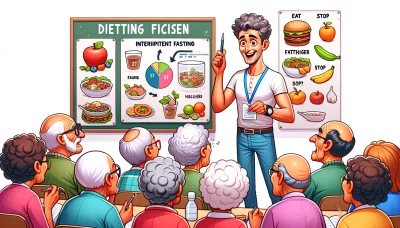Eat stop eat success stories Quiz
Test Your Knowledge
Question of
Understanding Eat Stop Eat
Origins of Intermittent Fasting
Fasting is not a new concept; it's been practiced for centuries across various cultures and religions. Historical records show that fasting has been used as a means of spiritual cleansing, political protest, and health improvement. Its roots are as deep and widespread as human civilization itself.
The scientific community has been fascinated by the effects of fasting on human health. Research indicates that strategic fasting periods can trigger important metabolic processes, including cellular repair and insulin sensitivity enhancements. These findings have propelled the popularity of intermittent fasting into the limelight.
Modern diets have integrated intermittent fasting in many forms, with Eat Stop Eat being a prominent methodology. The rise of this practice is fueled by its simplicity and the growing body of evidence supporting its benefits for weight loss and overall health improvement.
Principles of Eat Stop Eat
At the core of Eat Stop Eat is the concept of a 24-hour fast. This involves selecting one or two non-consecutive days per week where no calories are consumed. During fasting periods, your body is encouraged to use stored fat as fuel, leading to potential weight loss.
The balance between feasting and fasting is crucial in Eat Stop Eat. On non-fasting days, normal eating patterns resume without any caloric restrictions, enabling individuals to enjoy their favorite foods while still potentially reaping the benefits of intermittent fasting.
- Maintain hydration: Drink plenty of water during the fast.
- Stay busy: Engage in regular activities to keep your mind off food.
- Avoid overeating post-fast: Resume eating with a normal-sized meal, not a feast.
- Listen to your body: If you experience adverse effects, reconsider the fasting plan.
- Consistency is key: Regular fasting periods can increase effectiveness.
- Nutrient-rich diet: Focus on nutrient-dense foods during non-fasting periods.
- Avoid strenuous exercise: During fasts, opt for light to moderate physical activity.
Beyond weight management, Eat Stop Eat may offer psychological benefits such as improved self-control and a better relationship with food. Physically, it can contribute to improved biomarkers like reduced inflammation and enhanced brain health. Embrace the journey with enthusiasm your body might just thank you for it!
Real-Life Success Stories
Weight Loss Achievements
Witnessing real people conquer their weight loss goals is nothing short of inspirational! It's not just about the numbers on the scale, but the incredible transformations and the newfound confidence that comes with it. These achievements are landmarks in personal health journeys, showcasing discipline and determination.
The shedding of significant pounds is often the most visible sign of weight loss success. Individuals have turned their lives around by dropping 50, 100, or even more pounds. These staggering numbers are a testament to what can be accomplished with the right mindset and support.
Changes in body composition are equally striking. Muscle gain coupled with fat loss leads to a complete body transformation that's more than skin deep. This reshaping brings forth a healthier physique that's not only leaner but also stronger and more toned.
Maintaining weight loss over the long term is arguably the most impressive feat. It requires ongoing commitment to healthy eating and regular exercise, proving that lifestyle changes, not quick fixes, are the key to sustained success.
- Start with realistic goals and celebrate small victories.
- Incorporate a balanced diet rich in whole foods.
- Find an enjoyable form of exercise to stay consistent.
- Seek support from friends, family, or weight loss communities.
- Keep a journal to track progress and reflect on your journey.
- Avoid comparing your progress to others each journey is unique!
- Prepare for setbacks and have strategies to overcome them.
- Prioritize sleep and stress management for overall well-being.
- Stay informed on nutritional information and wellness tips.
- Remember maintenance is a continuous process; adapt as needed!
Health and Wellness Improvements
The realm of health and wellness improvements extends far beyond physical appearance. It's a holistic upgrade that includes metabolic health, energy levels, and overall quality of life. These stories serve as powerful motivation for anyone looking to enhance their well-being.
Enhanced metabolic health is one of the unsung heroes of wellness transformations. Reductions in blood sugar levels, cholesterol, and blood pressure signify profound changes within, reducing risks of chronic diseases like diabetes and heart disease.
An increase in energy levels is frequently reported by those who've made significant lifestyle adjustments. This newfound vigor fuels daily activities, workouts, and productivity, making every task feel less like an obligation and more like an opportunity to thrive!
Better sleep quality often accompanies these health improvements. Quality restorative sleep has profound effects on mood regulation, cognitive function, and even weight management it's a cornerstone of good health that cannot be overstated!
- Eat nutrient-dense foods to fuel your body properly.
- Incorporate regular physical activity into your routine.
- Foster mental health through mindfulness or meditation practices.
- Prioritize sleep by establishing a consistent bedtime routine.
- Stay hydrated throughout the day for optimal bodily functions.
- Leverage social connections for emotional support and motivation.
- Regularly consult healthcare professionals for personalized advice.
- Avoid sedentary behavior by taking breaks to move around during long periods of sitting.
- Limit processed foods high in sugars, sodium, and unhealthy fats.
- Experiment with different forms of exercise to find what you enjoy most!
Comparing Diets: Eat Stop Eat vs. Others
Keto Diet Versus Eat Stop Eat
Ketosis Explained
The Keto diet revolves around the metabolic state of ketosis, where the body burns fat for fuel instead of carbohydrates. This shift happens when carb intake is drastically reduced, prompting the liver to produce ketones. The allure of rapid weight loss through fat burning makes Keto a popular choice for many.
Eat Stop Eat does not necessarily induce ketosis as it's a pattern of intermittent fasting rather than a carb-restrictive plan. This approach focuses on extended periods of no food intake, aiming to create a calorie deficit over time, which can lead to weight loss without specific macronutrient targets.
Comparing Meal Plans and Restrictions
The Keto diet imposes strict carb limitations, usually capping daily intake at around 20-50 grams. Protein and fat become the primary nutrients, with meals rich in meats, cheeses, and low-carb vegetables. By contrast, Eat Stop Eat has no such restrictions; it's all about timing. You eat normally most days, then periodically fast for 24 hours.
Adherence to the Keto diet requires meticulous tracking of macronutrients to maintain ketosis. In contrast, Eat Stop Eat offers greater flexibility on non-fasting days, potentially making it easier for some to stick with long-term.
Evaluating Weight Loss Results
Both Keto and Eat Stop Eat can lead to significant weight loss. Ketos consistent approach may offer quicker results initially due to water weight loss from reduced carb intake. However, sustainability is often debated due to its restrictive nature.
Eat Stop Eat promotes a calorie deficit over time which can also result in weight loss but may be more gradual. It's considered by proponents to be more sustainable due to its less restrictive nature on non-fasting days.
Paleo Diet and Eat Stop Eat
Understanding the Paleo Principles
The Paleo diet is founded on the principle of eating like our Paleolithic ancestors - lean meats, fish, fruits, vegetables, nuts, and seeds are staples while grains, legumes, and dairy are avoided. This diet aims to reduce processed food intake and promote whole foods for better health outcomes.
Eat Stop Eat doesn't prescribe what foods should be eaten but rather when you should eat them. Its centered on fasting intervals that lead to reduced caloric intake over time without specific dietary restrictions during eating periods.
How Fasting Integrates with Paleo
Fasting can easily integrate with the Paleo diet as both emphasize whole foods and natural eating patterns. Practitioners often find that adopting intermittent fasting alongside Paleo principles can enhance fat loss while maintaining muscle mass due to the protein-rich diet.
Intermittent fasting like Eat Stop Eat could complement Paleo's emphasis on food quality by adding an element of meal timing discipline that may amplify benefits such as improved metabolic health and increased longevity.
Similarities and Differences in Health Outcomes
- *
- Similarities: Both diets can improve metabolic markers like blood sugar levels and cholesterol profiles due to their emphasis on whole foods and potential for calorie reduction. *
- Differences: Paleo focuses heavily on food sources and composition while Eat Stop Eat is concerned with meal timing and frequency. The impact on lifestyle can vary greatly between these two approaches. *
- Sustainability: Some individuals find Paleo difficult due to dietary restrictions whereas others may struggle with the fasting aspect of Eat Stop Eat; personal preference plays a big role in long-term adherence. *
- Nutrient Intake: Paleo dieters might have a more consistent nutrient intake across all food groups while those practicing Eat Stop Eat must ensure they receive adequate nutrition during their eating windows.
Overcoming Challenges with Intermittent Fasting
Dealing with Hunger Pangs
Hunger pangs can be a significant hurdle when starting intermittent fasting. Recognizing the difference between true hunger and habitual eating triggers is crucial. True hunger develops gradually and will persist or increase over time, whereas false hunger is temporary and often linked to emotions or routine.
Strategies to manage cravings are vital for success in intermittent fasting. Planning your fasting schedule around your lifestyle can help, as well as keeping healthy snacks on hand for your eating windows. It's also beneficial to identify emotional triggers that may lead to cravings and develop strategies to combat them.
- Drink water or herbal tea to mitigate mild hunger.
- Stay occupied with tasks or hobbies to distract from cravings.
- Practice mindful eating during your feeding periods.
- Avoid high-sugar foods that can spike insulin and increase hunger pangs.
- Eat protein-rich foods to promote satiety during your eating window.
Staying hydrated and busy are effective ways to combat hunger. Water can fill the stomach and reduce the sensation of emptiness. Engaging in activities, especially those that require focus or physical effort, can take your mind off food until it's time to eat.
Social and Lifestyle Adjustments
Navigating social events while fasting requires planning and communication. Informing friends and family about your fasting schedule can help avoid awkward situations. If an event falls within a fasting period, consider adjusting your fasting hours slightly if it won't disrupt your routine too much.
- Schedule social gatherings during your eating windows when possible.
- If you must attend an event during a fast, stay focused on socializing rather than eating.
- Be prepared to politely decline food offers without feeling pressured.
- Remember, occasional flexibility won't derail your progress; balance is key.
Integrating fasting into a busy lifestyle can seem daunting at first. However, many find that having fewer meals to plan actually frees up time. Preparing meals in advance for eating windows ensures you have nutritious options that align with your goals and schedule.
Maintaining balance and flexibility is essential for long-term success with intermittent fasting. Recognize that perfection isn't the goal; consistency is. Allow yourself the flexibility to adapt your fasting schedule as needed based on life's demands while maintaining overall consistency with the practice.
Nutrition and Fasting: Eating Smart
Meal Planning for Non-Fasting Days
Meal planning on non-fasting days is a game-changer! It's about more than just satisfying hunger; it's about fueling your body efficiently. Striking the right balance of macronutrients carbohydrates, proteins, and fats is crucial. This balance supports sustained energy, muscle repair, and overall health. It's not just what you eat, but how you eat it!
Embrace whole foods like a champion! They're packed with nutrients that are often lost in processed alternatives. Whole grains, lean meats, legumes, fruits, and vegetables provide a powerhouse of vitamins and minerals to keep your body running at its peak performance. This focus helps in maintaining optimal health and supports the body's recovery during non-fasting periods.
Timing and portion control can't be overlooked. Eating at regular intervals can help maintain blood sugar levels, while portion control keeps calorie intake in check. This strategy aids in preventing overeating on non-fasting days a common pitfall for many fasters.
Essential Nutrients During Eating Windows
When your eating window opens, it's time to prioritize nutrients! Vitamins and minerals are your allies in this journey. They play a pivotal role in metabolic processes, immunity, and overall wellbeing. Make sure to include a variety of colorful fruits and vegetables to cover all your bases.
Protein isn't just for bodybuilders it's essential for everyone, especially when fasting! It helps preserve muscle mass and promotes satiety. Including high-quality protein sources like lean meats, fish, eggs, or plant-based options like quinoa and beans is key to keeping those muscles strong and hunger at bay.
- Maximize Vitamin Intake: Leafy greens for iron, citrus fruits for vitamin C.
- Boost Mineral Levels: Nuts for magnesium, dairy or fortified alternatives for calcium.
- Prioritize Lean Protein: Chicken breast, tofu, lentils.
- Fiber Is Your Friend: Berries, oats, and whole grain products.
- Stay Hydrated: Water is essential; don't forget herbal teas!
- Say Yes to Healthy Fats: Avocadoes and salmon support hormone health.
- Sensible Snacking: Choose snacks that provide nutritional value.
- Mindful Supplements: Consider consulting a nutritionist for personalized supplement advice.
Lastly, don't forget fiber your digestive system will thank you! Fiber-rich foods not only aid digestion but also contribute to feeling full longer after meals. Whole grains, legumes, nuts, seeds, fruits, and vegetables are fantastic sources that can easily be incorporated into any meal.
Exercise and Eat Stop Eat Protocol
Training on Fasting Days
Adjusting workout intensity during fasting days is crucial to maintain energy levels and prevent burnout. It's important to strike a balance between keeping active and not overexerting yourself. Light to moderate exercises can be beneficial, but high-intensity workouts may require more energy than what your body can spare during a fast.
When it comes to timing exercises with fasting periods , the key is synchronization. Plan lighter workouts towards the end of your fasting period, so you can fuel up right after. This timing helps in maintaining muscle mass and replenishing your energy stores more efficiently once you break the fast.
Always focus on listening to your body's signals . Fasting introduces a different rhythm to your metabolism, so it's essential to pay attention to how your body responds during workouts. If you feel dizzy or excessively tired, it might be time to ease up on the intensity or duration of exercise.
- Maintain hydration even if calorie intake is restricted.
- Consider yoga or walking, which are less taxing on energy reserves.
- Avoid heavy weight lifting on an empty stomach to prevent muscle loss.
- Keep workouts short; prolonged sessions can lead to increased hunger and fatigue.
Post-Fast Workouts for Optimal Results
To maximize muscle growth post-fast , timing is everything. Engage in resistance training shortly after you've had a meal. This approach leverages the heightened insulin sensitivity post-fast, driving nutrients into muscle cells and promoting growth.
Recovery nutrition strategies are integral after post-fast workouts. Your body needs the right mix of proteins and carbohydrates to repair and build muscles. A balanced meal post-workout can lead to better results and improved recovery times.
Balancing cardio and strength training after a fast can help maximize fat loss while preserving muscle mass. Implement cardio for fat burning, but don't forget strength training exercises that are essential for maintaining lean body mass and improving overall metabolic rate.
- Eat a balanced meal with proteins and carbs within 30 minutes post-workout.
- Incorporate a mix of compound movements like squats, deadlifts, and bench presses for full-body engagement.
- Avoid excessive cardio that could lead to muscle catabolism; keep it moderate.
- Ensure adequate sleep for optimal muscle recovery; aim for 7-9 hours per night.
- Maintain consistency in your training schedule for sustainable results.
Mental and Emotional Aspects of Fasting Diets
Mindfulness and Eating Habits
Embarking on a fasting diet isn't just about the physical transformation; it's a mental and emotional journey as well. Mindfulness plays a pivotal role in this process, teaching us to pay attention to our body's hunger and fullness signals. By focusing on the present moment, we can discern between true hunger and mindless snacking, leading to more thoughtful eating patterns.
Fasting brings our emotional relationship with food into sharp focus. It's crucial to differentiate between eating prompted by emotional needs and eating driven by physical hunger. This self-awareness can be instrumental in breaking free from emotional eating habits that often sabotage dieting efforts.
Integrating meditation into your fasting routine can amplify your success. Meditation encourages a heightened state of awareness and self-control, thus supporting your fasting journey. It teaches you to approach cravings with a sense of calm rather than stress, aligning your mental state with your physical goals.
Building Resilience and Discipline
To make the most of a fasting diet, setting achievable goals is essential. Start with short fasting periods and gradually increase them. This incremental approach helps build resilience without overwhelming yourself. Remember, consistency over time yields results!
It's normal to face challenges when adapting to a new eating pattern like fasting. When setbacks occur, it's important not to dwell on them. Instead, use them as learning opportunities to strengthen your resolve and refine your strategy moving forward.
Celebrate every victory along your fasting journey, no matter how small! Recognizing milestones reinforces positive behavior and motivates you to keep pushing forward. Whether it's resisting a craving or reaching a fasting milestone, each success is a step towards mastering the mental game of fasting.
- Start each meal with a moment of gratitude or reflection to set a mindful tone.
- Eat slowly and chew thoroughly to enhance digestion and recognition of satiety cues.
- Eliminate distractions such as TV or smartphones during meals to focus on the act of eating.
- Use smaller plates or bowls to help control portion sizes and prevent overeating.
- Keep a food journal to track not only what you eat but also how you feel emotionally before and after meals.
- Schedule meals at consistent times to maintain regularity and avoid impulsive eating.
- Stay hydrated throughout the day, as thirst can often be mistaken for hunger.
- Avoid grocery shopping while hungry to prevent impromptu purchases of unhealthy foods.
- Practice saying "no" politely but firmly when offered food outside of planned meals or fasting windows.
- Seek support from friends or online communities who understand the challenges of mindful eating during fasting.
- Avoid setting overly ambitious goals that may lead to disappointment or burnout.
- Don't ignore signs of physical distress; listen to your body and adjust your fasting plan accordingly.
- Avoid comparing your progress with others; focus on your own journey and personal growth.
- Do not neglect other aspects of health such as sleep quality, hydration, and stress management while focusing solely on fasting.
- Avoid strict rigidity; allow for flexibility in your fasting schedule when needed without feeling guilty.
- Refrain from using setbacks as an excuse to give up; instead, reassess and pivot your approach if necessary.
- Avoid underestimating the power of small victories; they build momentum towards larger successes in the long run.
- Resist the urge to fast too frequently without adequate recovery time which could lead to adverse effects on health.
- Avoid relying solely on willpower; create an environment that supports your goals (e.g., removing temptations from home).
- Dodge extremes in dietary restrictions post-fasting periods which could lead to binge-eating behaviors.
Long-Term Sustainability of Eat Stop Eat
Adapting Fasting as a Lifestyle Choice
Embracing Eat Stop Eat is about more than temporary dieting; it's about integrating fasting into your life for the long haul. It isn't a quick fix but rather a profound shift in how you approach eating and health.
To ensure a smooth transition, begin with small fasting intervals and gradually increase. This incremental approach helps your body adjust without overwhelming it, paving the way for sustainable change.
Finding what works best for your schedule and sticking to it can make all the difference. Personalizing your fasting plan ensures it aligns with your daily routine, increasing the likelihood of long-term adherence.
Maintaining enthusiasm is key! Surround yourself with a community of fellow fasters, celebrate milestones, and keep reminding yourself of the health benefits to stay motivated.
- Start small and build up your fasting duration over time.
- Fit fasting into your lifestyle, not the other way around.
- Join fasting forums or groups for support and motivation.
- Keep track of the positive changes to bolster commitment.
Monitoring Health and Wellness Progress
As you embark on this journey, regular check-ins with healthcare professionals are crucial. They offer expert guidance and ensure that your fasting regimen complements your health needs.
Tracking biomarkers such as blood glucose levels and body composition is invaluable. These metrics provide tangible evidence of progress and can be used to tailor your diet to achieve optimal results.
Lifestyle changes, aging, or health conditions may necessitate dietary adjustments. Stay flexible and ready to modify your fasting routine in response to these changes.
- Schedule regular appointments with healthcare providers.
- Use health tracking apps or journals for monitoring progress.
- Be prepared to adapt your approach as your body's needs evolve.
- Remember that personal well-being should always take precedence over rigid adherence to any diet plan.












